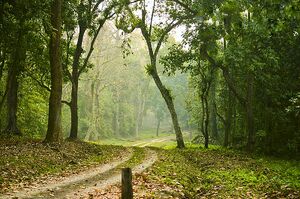Siliguri
| Author:Laxman Burdak, IFS (R) |

Siliguri (सिलीगुड़ी) is a city which spans areas of the Darjeeling and Jalpaiguri districts in the Indian state of West Bengal. Known as The Gateway of Northeast India, Siliguri is popular for three Ts - tea, timber and tourism.[1]
Location
It is located on the banks of the Mahananda River at the foothills of the Himalayas. It lies 40 kilometres west of its twin city, Jalpaiguri. The merging of the two cities make them the largest metropolis of the region. Teesta river is not so far from the city.
Siliguri has great strategic importance in West Bengal. It is located conveniently, connecting four international borders i.e. China, Nepal, Bangladesh and Bhutan. It also connects the North-East with the Indian mainland and is connected with all other districts of West Bengal. Located at the foothills of Eastern Himalaya, Siliguri is a trading and transportation hub. Over time, Siliguri has grown from a village into a commercial hub.[2]
History
According to Sailen Debnath, "Siliguri" means a stack of pebbles or stones. Until the 19th century this region was called as "Shilchaguri" when there was dense Dolka forest covering the area. Because of its appeal as an agricultural village, the Kingdom of Sikkim captured Siliguri making it the southernmost part of their kingdom until the Kingdom of Nepal interfered. Because of it Kirati and Nepalis came to settle in this region.[3]
Siliguri saw rapid urbanisation under the British rule and that was reflected in its local governance as well. The earliest form of local urban governance as a Sanitation Committee set up in 1915.[56] Its function was to dispose off night soil. Till 1921, most aspects of local governance in Darjeeling district, including Siliguri, was looked after by the Darjeeling Improvement Fund. In 1922, Siliguri Local Board with nominated members was created under the Bengal Local Self Government Act, 1885. In 1938, the Union Board was set up in Siliguri under the Bengal Village Self-Government Act, 1919 and it provided public utilities in the city.
Flora and fauna

Siliguri and surrounding Sub-Himalayan forests are rich in fauna diversity, the plains of North Bengal (Siliguri, Jalpaiguri, Cooch Behar etc.) are surrounded by deep forests. These forests are home of various rare and common species of plants. The forest here is moist Tropical and characterised by dense growth of tall Sal i.e. Shorea robusta. Sal occupies about 80% of all vegetation in these tropical forest.
These forests are categorised by their dominating plant species such as 1) East Himalayan Sal Forest present on the lower slopes of Mahananda Wildlife Sanctuary contains Sal, Khair, Simul, Sissoo, Riverine grasslands and various rare species of plants like Orchids 2) East Himalayan Upper Bhabar Sal mainly present at Jalpaiguri district which is characterised by dense population of Microstegium chiliatum, Sal i.e. Shorea robusta. Others are Terminalia tomentosa, Schima wallichii And the 3) Eastern Tarai Sal Forest generally found in lower altitudes compared to other two types of forest. This type of forest characterised by various species of bamboos, ferns, and Sal which is found in Baikunthapur Forest, near Siliguri city.[4]
Rapid growth of city causing deforestation, making Siliguri warmer day by day and unbalancing the ecosystem.
Fauna
Siliguri is located in the Terai region ("moist land"), a belt of marshy grasslands and dense tropical deciduous moist forests at the base of Himalaya range which is rich in biodiversity, containing numerous rare species of flora and fauna. These forests are characterised by their distinct wildlife variety. Mahananda Wildlife Sanctuary near Siliguri is famous for elephants. Sukna is the gateway to this sanctuary, which is 12 km from Siliguri.
These sub-Himalayan forests are the home of various types of wild animals like the elephant, tiger, Indian bison, barking deer, wild pig, monkey, civet, snake, lizard, mountain goat, sambar, chetal and fishing cat. These forests are also home of about 243 different bird species like the pied hornbill, egret, kingfisher, drongo, fly catcher, woodpecker and others. Another common sight is migratory water birds.[5]
सिलीगुड़ी
सिलीगुड़ी (Siliguri) : सिलीगुड़ी दार्जिलिंग जिले में रेल और राजपथ का अंतस्थ होने के कारण, दार्जिलिंग एवं सिक्किम के व्यापार का केंद्र है. जूट व्यवसाय नगर का प्रमुख व्यवसाय है. यह महानन्दा नदी के किनारे हिमालय के चरणों में स्थित है और जलपाईगुड़ी से 40 किमी दूरी पर स्थित है. यह उत्तरी बंगाल का प्रमुख वाणिज्यिक, पर्यटक, आवागमन, तथा शैक्षिक केन्द्र है. गुवाहाटी के बाद यह पूर्वोत्तर भारत का दूसरा सबसे बड़ा नगर है. यह पश्चिम बंगाल का महत्वपूर्ण व्यापार केन्द्र बन चुका है. नेपाल, भूटान तथा बांग्लादेश आदि पड़ोसी देशों और अन्य पूर्वोत्तर राज्यों के लोगों के लिये भी यह वायु, सड़क तथा रेल यात्रा का पड़ाव बिन्दु है. यह चाय, आवागमन, पर्यटन तथा इमारती लकड़ी के लिये प्रसिद्ध है.
External links
References
- ↑ "Siliguri- the gateway to the northeast India". www.siligurismc.in.
- ↑ History of Siliguri-SMC".
- ↑ "Middle age history of Siliguri" (PDF). asiscwb.org.
- ↑ "West Bengal Forest Department". Westbengalforest.gov.in.
- ↑ "FLORA AND FAUNA OF NORTH BENGAL". Nbtourism.tripod.com.

